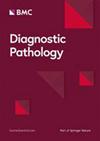年轻和高龄尤文肉瘤患者的临床病理特征和遗传特征
IF 2.4
3区 医学
Q2 PATHOLOGY
引用次数: 0
摘要
尤文肉瘤(EwS)是一种高度恶性的异质性肿瘤。探索EwS的临床病理特征和遗传学特征对预后和治疗方案至关重要。根据组织学、表型和新一代测序(NGS)检测结果,分析了年轻(≤30 岁)和高龄(>30 岁)EwS 患者的临床病理特征和遗传特征。年轻组(18/36)呈现非典型 EwS 组织学形态,而高龄组(18/36)呈现典型形态。对于初诊时没有转移的患者,年轻组的预后比年长组差。对 20 例骨膜外 EwS 患者进行了基于 DNA 和 RNA 的 NGS 研究。16/20 份样本显示 EWSR1-FLI1 融合,4/20 份显示 EWSR1-ERG 融合。然而,13/16 例 EWSR1-FLI1 融合在基于 DNA 和 RNA 的 NGS 中均被检测到,1/16 例仅在 DNA 水平被检测到,2/16 例仅在 RNA 水平被检测到。对EWSR1-FLI1病例遗传特征的分析表明,年轻组倾向于伴有更多的拷贝数变异(CNV),如CCND1、CDK4扩增,以及融合变异,如CHEK1-EWSR1、SLIT2-EWSR1和EWSR1-FAM76B融合。高龄组更有可能出现SNV或Indel突变,如EPHA3和STAG2突变。此外,与主要存在SNP变异的患者相比,有更多CNV异常的患者预后更差。此外,与高龄组相比,年轻组的CyclinD1蛋白表达量明显更高。年轻和高龄EwS患者的临床病理特征和遗传特征存在明显差异。针对年龄亚组的细胞周期失调可能是治疗尤文肉瘤的一种潜在策略。本文章由计算机程序翻译,如有差异,请以英文原文为准。
Clinicopathological characteristics and genetic features of young and senior Ewing sarcoma patients
Ewing sarcoma (EwS) is a highly malignant and heterogeneous tumor. Exploring clinicopathological characteristics and genetic features of EwS is critical for prognosis and treatment regimen. Clinicopathological characteristics and genetic features of young (≤ 30y) and senior (> 30y) EwS patients were analyzed based on histology, phenotype, and next-generation sequencing (NGS) detection. The young group (18/36) presented nontypical EwS histological morphology, whereas the senior group (18/36) presented typical morphology. The prognosis of the young group was found to be worse compared with the senior group for patients without metastasis at the initial diagnosis. DNA- and RNA-based NGS was conducted on 20 extraosseous EwS patients. 16/20 samples demonstrated EWSR1-FLI1 fusion and 4/20 demonstrated EWSR1-ERG fusion. However, 13/16 EWSR1-FLI1fusions were detected both in DNA- and RNA-based NGS, 1/16 was detected only at the DNA level, and 2/16 were detected only at the RNA level. An analysis of the genetic profiles of the EWSR1-FLI1 cases revealed that the young group was inclined to couple with more copy number variations (CNV), such as CCND1, CDK4 amplification, and fusion variations, such as CHEK1-EWSR1, SLIT2-EWSR1, and EWSR1-FAM76B fusion. The senior group was more likely to have SNV or Indel mutations, such as EPHA3 and STAG2 mutations. Moreover, patients with more CNV abnormalities had a worse prognosis than those with predominantly SNP variants. In addition, compared with the senior group, the young group had significantly higher CyclinD1 protein expression. Clinicopathological characteristics and genetic features in young and senior EwS patients differed significantly. Targeting cell cycle dysregulation based on age subgroup may be a potential therapeutic strategy for Ewing sarcoma.
求助全文
通过发布文献求助,成功后即可免费获取论文全文。
去求助
来源期刊

Diagnostic Pathology
医学-病理学
CiteScore
4.60
自引率
0.00%
发文量
93
审稿时长
1 months
期刊介绍:
Diagnostic Pathology is an open access, peer-reviewed, online journal that considers research in surgical and clinical pathology, immunology, and biology, with a special focus on cutting-edge approaches in diagnostic pathology and tissue-based therapy. The journal covers all aspects of surgical pathology, including classic diagnostic pathology, prognosis-related diagnosis (tumor stages, prognosis markers, such as MIB-percentage, hormone receptors, etc.), and therapy-related findings. The journal also focuses on the technological aspects of pathology, including molecular biology techniques, morphometry aspects (stereology, DNA analysis, syntactic structure analysis), communication aspects (telecommunication, virtual microscopy, virtual pathology institutions, etc.), and electronic education and quality assurance (for example interactive publication, on-line references with automated updating, etc.).
 求助内容:
求助内容: 应助结果提醒方式:
应助结果提醒方式:


